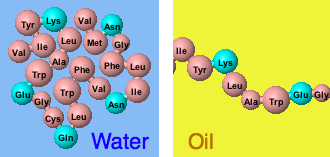User:Shraddha Desai/Sandbox1 Salmonella L-asparaginase II
From Proteopedia
Abstract
|
Structure Analysis of Escherichia coli Asparaginase II
By Dominic Fiorentino, Shraddha Desai, Dhaval Upadhyay and Ahmed Abdelrahman
PDB#3eca
salmonella enterica serovar Typhimurium (S.Typhimurium) uses Asparagine II to evade the development of T cell-mediated adaptive immunity by interfering with T cell priming. Asparagine II had a direct inhibtory effect on the naïve Tcells from mouse, blocking the proliferation.[1] The complete structure of Asparaginase II of salmonella is not fully determined, although it is 95% homologous to L-asparaginase of Escherichia coli. L-asparaginase of E.coli, is a tetramer with two identical active domains A and C. L-asparaginase has been used for treatment of acute lymphoblastic leukemia. This model will display and further study the active site of chain A. the hydrogen bonds of the Helices (shown in light magenta) help in the overall stability of molecule.
It is speculated that The enzymatic activity of asparginase starts with a nucleophilic attack on the β-amide group of asparagines, leading to acyl-enzyme intermediate. Aspartate contacts number of polar side chains to anchor the substrate with the product. The main-chain nitrogen and the Oɣ of form hydrogen bonds with the β-carboxyl group of aspartate. Thr 89(orange) is the most likely candidate as the nucleophile that attacks the aspartate. The only basic residue in the active site region that could influence the nucleophilic character of Thr89 is Lys162 (dark blue). The positions of Thr12 (yellow) stabilize the tetrahedral intermediate formed between Thr89 and its substrates. The hydrogen bonds between the nitrogen atom of aspartate and the adjacent amino acids facilitate the binding of the substrate and stabilization of the transition states. The oxygen of Ser58 (light blue) interacts with the hydrogen of the alpha-carboxyl group. Serine is another nucleophile candidate in the asparginase II enzymatic activity only if the aspartate is in an opposite orientation the asparagene substrate.
Swain Amy, et all. “Crystal structure of Escherichia coli L-asparaginase, an enzyme used in cancer therapy.” Proc. Natl. Acad. Sci. February 1993: 1474-1478. Print.
Introduction
T cell mediated adaptive immunity is required to fight against infections with an intracellular facultative bacterial pathogen, Salmonella entericaserovar Typhimurium (S.Typhimurium). Macrophagesand neutrophils are some inflammatory cells of the immune system that provide the first line of defense against pathogenic microorganisms. Lymphocytes such as T cells are the ultimate response to clear the microbial infection. The study shows that the immune response to the S. Typhimurium is slow and in-efficient which reduces the amounts of surface and intracellular TCR-B proteins as seen by the down modulation of TCR-B protein [a receptor molecule required for Ag (silver) recognition and T cell function] when cultured in presence of S.Typhimurium. The contact between S. Typhimurium and T cells reduces the expression of TCR-B that is secreted. Furthuremore, the study explores why S. Typhimurium plays an active role in inhibitingdevelopment of protective immunity. A genetic screen was used to identify the salmonella genes required for T cell inhibition. This screen identified the gene ansB which codes for L-asparaginase II.
L-asparaginase II produced by the Salmonella, catalyzes the hydrolysis of L-asparagine to L-aspartate and ammonia. Type I asparaginase is located in the cytosol, whereas type II asparaginase in located in the periplasmic region (the space between the inner and outer membrane) of the bacteria and has a much higher affinity for asparagines. Thus, the rasmol program is used to create a model of wild type E.coliL asparaginase II enzyme showing helices, and amino acids such as , Lys162, Thr12, Ser58, and Asp90 to study the structure of L-asparaginaseII of salmonella . Since the structure of Salmonella L-asparaginase II is not determined which is 95% homologous (determined by blasting) to E.coli L-Asparaginase II since the structure of of L-asparaginase II of salmonella is still not developed. If an uninfected subject is administered with E.coli L-asparaginase II, it causes down moduilation of TCR-B expression as seen in the wild type S. Typhimurium infected subject.

